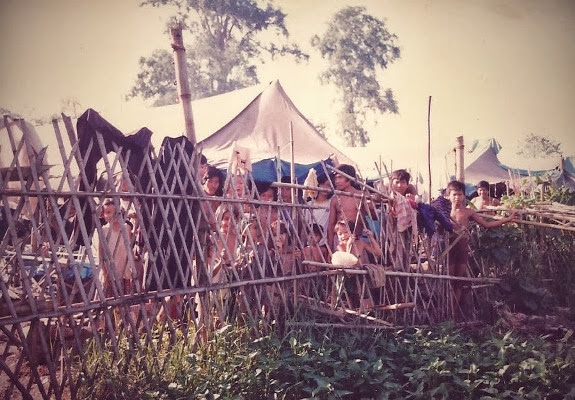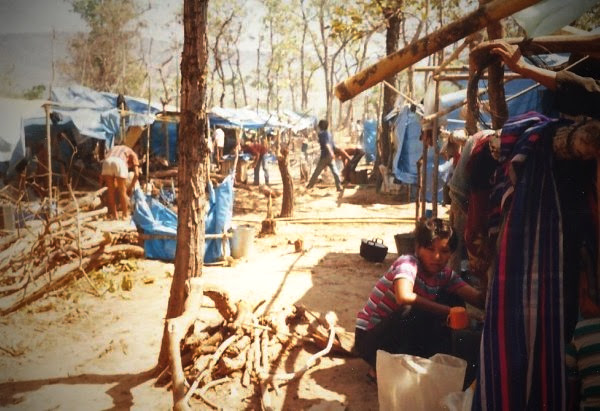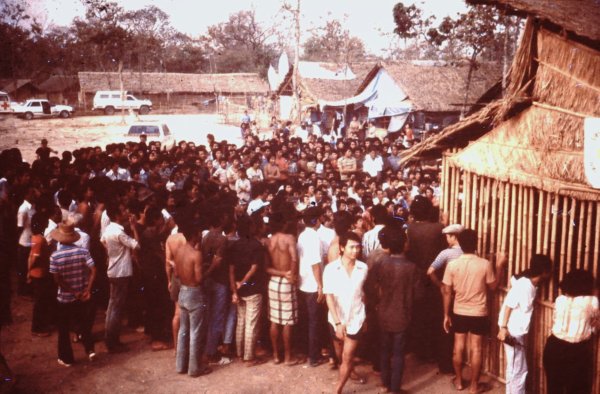L'humanitaire, c'est aussi traiter de l'exclusion …et pour ça, nul besoin d'aller à l'autre bout du monde! (Stéphane Rousseau)
The original story could be viewed at Stéphane's blog here:
http://mes-ptites-histoires.blogspot.com/2010/05/une-photo-une-histoire-la-petite-oeup.html
 |
Stéphane Rousseau and the Little Oeup - Site 2, 1988
(photo courtesy of Stéphane Rousseau) |
Une photo = une histoire - La petite Oeup…
Un jour, alors que je marchais dans les travées du camp, je tombai sur une petite fille totalement défigurée; je ne l'identifiai d'ailleurs comme "fille" que parce qu'elle portait une petite robe. Curieux de savoir ce qui l'avait si affreusement mutilée, j'interrogeai la mère: celle–ci m'expliqua que lorsque la petite était encore tout bébé, la moustiquaire en nylon au-dessus son lit avait prit feu et était tombée sur elle, lui brûlant profondément les chairs, notamment du visage et des bras*. Elle s'appelait Oeup et avait 5 ans. Lui demandant si elle allait à la crèche comme les autres enfants de son âge dans le camp, la maman me répondit avec tristesse que l'école l'avait refusée à cause de son apparence. Quelque peu outré, je lui demandai alors si elle voulait bien que nous allions ensemble voir la directrice de la crèche pour tenter de la persuader d'accepter la petite Oeup dans son établissement, et lui permettre de vivre une vie sociale normale. La maman accepta. Nous montâmes dans ma voiture et partîmes sur le champ pour la crèche. Là, prenant Oeup dans mes bras (la photo) je rencontrai la directrice et lui demandai pourquoi la petite avait été refusée dans son établissement. La directrice m'expliqua avec moult larmoiements qu'elle voudrait bien l'accueillir, mais que les autres enfants en avaient peur, et que "...rien que de la regarder, ils en vomissaient". Je posai la petite à terre, et poursuivis ma discussion avec la directrice, qui n'en démordait pas. Soudain, en me retournant, que vis-je? La petite Oeup en train de jouer en toute tranquillité avec quelques nouveaux copains… je me tournai alors vers la directrice et lui demandai avec un sourire "-alors, il y a un problème?". Manifestement gênée, elle me répondit, "-…euh, apparemment non." "-alors vous la prendrez dorénavant?" "-oui, oui, pas de problème". Nous quittâmes l'établissement. Je redéposai la maman, heureuse, chez elle, l'invitant à me prévenir immédiatement si la petite Oeup était encore injustement rejetée à d'autres activités collectives des enfants de son âge. Elle acquiesça et nous nous séparâmes.
L'humanitaire, c'est aussi traiter de l'exclusion …et pour ça, nul besoin d'aller à l'autre bout du monde!
*
The original story could be viewed at Stéphane's blog here:
http://mes-ptites-histoires.blogspot.com/2010/05/une-photo-une-histoire-la-petite-oeup.html
* * *
*
One photo = one story - Little Oeup
 |
| (photo courtesy of Stephane Rousseau) |
One
day, while walking through the sections of site 2 refugee camp, I came
across a badly disfigured little girl. Actually, I could guess she was a
"girl" only because she was wearing a dress.
I wanted to know
what had mutilated her so horribly; I asked the mother and she explained
that when the little girl was still a baby, the nylon mosquito net over
her bed had caught fire and fallen on her, burning deeply the flesh of
her face and her arms. Her name was Oeup, and she was now 5 years old. I
asked if she was going to the kindergarten alike other children of her
age in the camp; the mother answered with sadness in her eyes that the
school had refused her because of her appearance. I was shocked and
asked the mother if she would mind me to talk to the director of the
kindergarten and try to persuade her to accept little Oeup, so as to
allow her to live a normal social life like other kids. The mother
agreed; she got into my truck and we drove to the kindergarten. There, I
took Oeup in my arms (photo) and we met the director of the
kindergarten. I asked her why the little girl had been denied enrolment
at the kindergarten. With a pitiful tone, the director claimed that she
would gladly welcome her, but that the other children were so afraid of
her disfigured face that "... only by seeing her face, they would throw
up."
I laid the little girl down and continued my discussion with
the director, who did not seem to budge. Then, all of a sudden, as I
turned my head, I saw Oeup… playing peacefully with other kids! I then
turned back to the director and asked her with a smile: "--So? Do you
see a problem? "
The director, obviously embarrassed, answered: "-- ...uh, obviously, no"
"-- if so, can you enrol her now ?"
"--yes, yes, I can, no problem."
I left Oeup at the kindergarten
playing with her new friends, and drove the mother back to her home.
Before I left, I asked her to let me know any time if little Oeup was
again unfairly denied activities that other children of her age enjoy in
the camp. She nodded and we parted.
Because the job of a
humanitarian worker is also to fight discrimination… and there is no
need to go to the other side of the world to just do that!
* * *
*
Câu chuyện của một bức ảnh: Em bé gái đáng thương tên Oeup
Một ngày kia khi tôi đang đi bộ trong trại tị nạn Site 2, tôi thấy một bé gái với gương mặt đầy vết sẹo bỏng, nhìn thật đáng sợ. Tôi nghĩ đây là một bé gái vì em đang mặt bộ đồ của con gái.
Tên em là Oeup, khoảng 5 tuổi khi tôi gặp. Không biết tại sao em bị bỏng như thế, tôi hỏi bà mẹ thì mới biết lúc đang ngũ trong mùng ni lông, mùng bị cháy ập xuống em, làm bỏng mặt và tay của em.
Tôi hỏi em có đến trường dành cho những trẻ em cùng tuổi không, bà mẹ buồn bả trả lời rằng trường không nhận em vì gương mặt trông dễ sợ của em. Tôi rất đổi kinh ngạc, hỏi nếu bà muốn đến trường với tôi để nói chuyện với hiệu trưởng cho em vào lớp học. Bà đồng ý, thế là tôi chở bà đi.
Tới trường tôi bồng em lên trên tay, (hình), hỏi bà hiệu trưởng tại sao không nhận em vào lớp, bà ta giải thích là bà rất sẳn sàng, nhưng bộ mặt kinh dị của em làm những trẻ em khác hoảng sợ. Theo lời bà thì "chỉ cần nhìn thấy mặt Oeup, những đứa trẻ đã thấy buồn nôn"
Tôi đặt Oeup xuống đất tiếp tục nói chuyện với bà hiệu trưởng. Rồi chợt tôi quay lại thấy Oeup đang chơi với những đứa trẻ cùng tuổi khác. Tôi mỉm cười nói với bà hiệu trưởng " bà thấy đó, đâu có vấn đề gì đâu, phải không?"
Hơi lúng túng bà ấp úng trả lời, " uhm..thì không vấn đề gì"
Tôi nói " vậy bà nhận Oeup chứ?"
" Ừ, ừ, đương nhiên rồi" bà trả lời.
Tôi để Oeup lại trường và chở bà mẹ về nhà, căn dặn kỷ lưởng là phải báo cho tôi hay ngay nếu Oeup bị từ chối không được tham gia những sinh hoạt khác như những em cùng trang lứa trong trại. Bà gật đầu, và tôi ra về.
Người làm việc từ thiện cũng phải tranh đấu cho kỳ thị bất công, chúng ta không cần phải đi đâu xa để làm việc ấy.
Các bạn có thể đọc bài nguyên bản câu chuyện bằng tiếng pháp của Stephane blog ở đây
http://mes-ptites-histoires.blogspot.com/2010/05/une-photo-une-histoire-la-petite-oeup.html























 Tuesday, December 24, 2013
Tuesday, December 24, 2013



















































